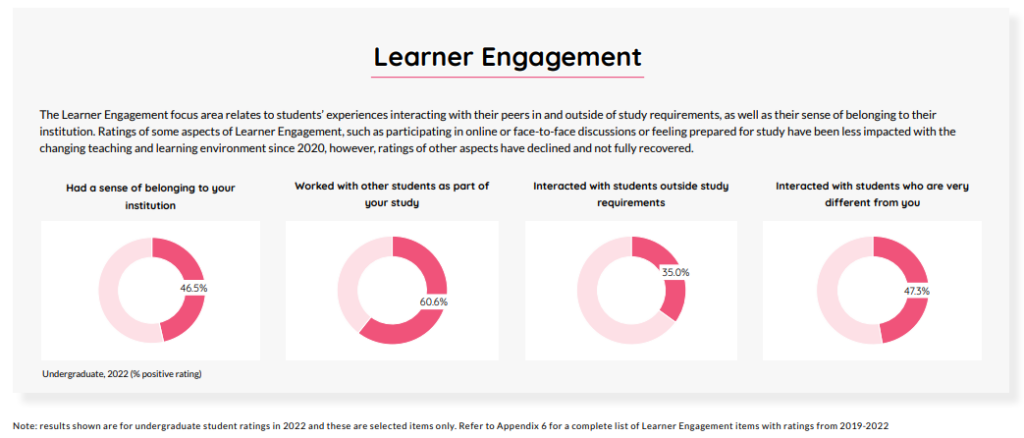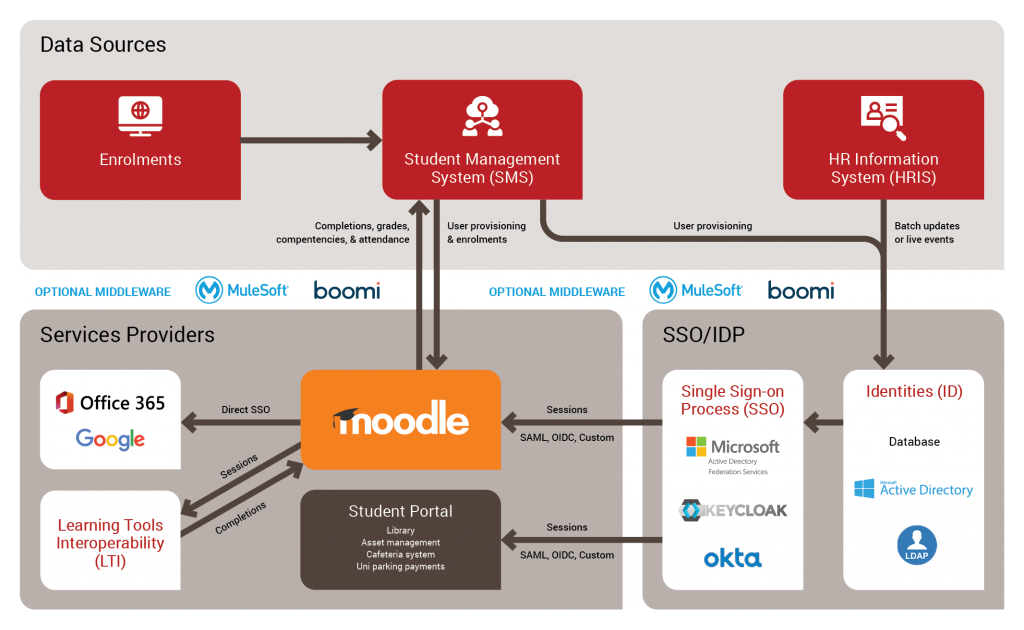Do you have all the right tools to deliver better student experience?
The Quality Indicators for Learning and Teaching (QILT) surveys that are carried out every year in Australia provide our higher education sector participants with independently sourced and managed performance data to help maintain and improve the quality of learning and teaching. It also forms the basis of the CompareED comparison website, that helps students review institutions and study areas, based on the real-life experiences of current students and recent graduates.
QILT Student Experience Survey (SES) Results – 2022 vs 2019
“The Student Experience Survey (SES) provides a national architecture for collecting data on key aspects of student experience. The SES focuses on aspects of the student experience that are measurable; linked with learning and development outcomes; and potentially able to be influenced by institutions.” Learn more here
The SES focus areas include: Skill Development, Learner Engagement, Teaching Quality, Student Support and Learning Resources.
Their recent report indicates that there was a significant decline in overall educational experience in 2020, assigned to the COVID-19 pandemic; and while the ratings improved over the following two years “with most focus areas recovering to the levels seen before 2019”, Learner Engagement and Student Support ratings are still struggling areas.
There are differences in results across demographic groups, levels of study (undergraduate vs postgraduate), study areas and institutions. Nevertheless, the results paint a good picture of overall trends across those five key areas and serve as a guide for both education providers and students.
Learner Engagement
The fact that student / learner engagement has been one of the major challenges for higher education providers is clearly evident, and not from the above report alone. Working with clients on a day to day basis, helping them with their EdTech solutions, and attending various education and EdTech conferences around the globe, we can confirm that Student Engagement is a topic of high attention. It is difficult for universities and colleges to deliver both:
- the personalisation and flexibility in teaching and learning modes (blended learning) and
- engagement (creating a sense of belonging for students, keeping them motivated and increasing learner retention rates).

Speaking of student retention, the 2022 SES report provides some interesting data on ‘Reasons considered leaving institution’ (page 39). Health, study / life balance, workload difficulties and ‘expectations not met’ are the top four reasons mentioned and all four have been on the increase between 2019 and 2022.
Why such studies are so valuable is that to improve anything you need to start with your end user in mind, understanding their pain points. You cannot, however, rely on secondary data alone. Having your own analytics systems and tools, collecting, analysing and acting upon own relevant data is important. Many education providers don’t have that in place. Those that do, will see improvement and growth.
Read: Moodle Administrators, how much control do you have over your site?
E-learning Technology for Student Engagement, Support and Success
Technology plays an integral part in supporting student engagement and success.
Some of the things you should be looking into include:
- When did the student last login to the learning management system (LMS)
- How often have they logged in over the semester?
- When logged into the LMS, how long did they stay logged in for?
- Has there been an obvious change in learning behaviour / routine?
- What do university attendance records say?
- Has there been any recent communications with students, from other areas of the university?
Capturing and tracking these statistics helps universities target resources where and when students need support most. We’ve worked with clients to help them leverage information from within their Moodle LMS platforms and integrate the information with other data sources from across the institution: CRMs, Student Information Systems, HRIS etc. So reach out if you need help with this.
When you are reviewing effectiveness of your EdTech solutions, remember it’s not just about your LMS platform. It’s about your entire digital ecosystem including:
- the quality of your virtual classroom software;
- tools for data collection and analysis;
- staff training and collaboration platforms; and
- how all the required software applications integrate in the simplest way possible to deliver a unified experience for your stakeholders.
We explored a topic of ‘Things you should be measuring for student success’ in a separate blog which you can view here.
Read: University of Canterbury wins a CAUDIT Award for Improving Student Succcess.
Student Experience Delivery
While you must start your roadmap to success with good data, there are various other things you must get right to deliver exceptional learner experience. These include:
- High Performance LMS
- Course content improvements
- Seamless delivery of assessments and high stakes exams
- Effective virtual classrooms
- Software integrations
From interactions with our own university LMS clients, a number of projects were initiated or given more urgency as a result of the COVID-19 Pandemic back in 2020, and the above five priorities came to the fore. Each is still relevant and deserving of a separate in-depth discussion. While this is beyond the scope of this blog, we’d like to highlight a few key points, case studies and links to other resources that expand on some of the above points. We also encourage you to browse through our blog and/or subscribe to our monthly newsletter to receive updates on similar topics.
Explore the customer success story
High performance LMS
A fundamental requirement of a virtual learning environment (VLE) is that it’s available and reliable. The nature of online learning dictates that your learning management system needs to be available 24/7, on-demand, when it’s convenient for your students.
Our universities look to us to optimise their cloud services, scaling when and where they need it, while at the same time, keeping their costs at a manageable level.
Disaster recovery has also been high on the agenda, with frequent or even real-time backups being a priority. No organisation wants to be the victim of ransomware, particularly when online delivery of your services is so critical.
Integration and authentication
Having an integrated system is key to enabling virtual and social learning: system integration across your environment and single sign-on (SSO) with multi-factor authentication (MFA) all serve to provide convenience and a positive user experience (UX) for your students.
We have previously produced an Authentication Series of blogs and videos to provide some insight into this important aspect of an optimal learning environment. View them below:
Moodle authentication Security with Peter Burnett
SSO – What it is and how it can benefit your organisation
MFA – What it is and why you need it
SAML – SSO with single log out

In Summary:
There’s plenty of evidence out there that student engagement and success has become an area of increased attention in the last few years. Keeping an eye on overall trends, measuring key factors affecting student experience more broadly, as well as in your institution more specifically, is important. Acting upon your collective data is even more so.
Education technologies can help universities and colleges improve their teaching and learning experience. It does, however, take a handful of tools that can integrate seamlessly; forming a reliable and flexible ecosystem that will serve your needs in the long run.
If you would like to explore how we can provide expert technical support for your LMS, we’d love to hear from you.


